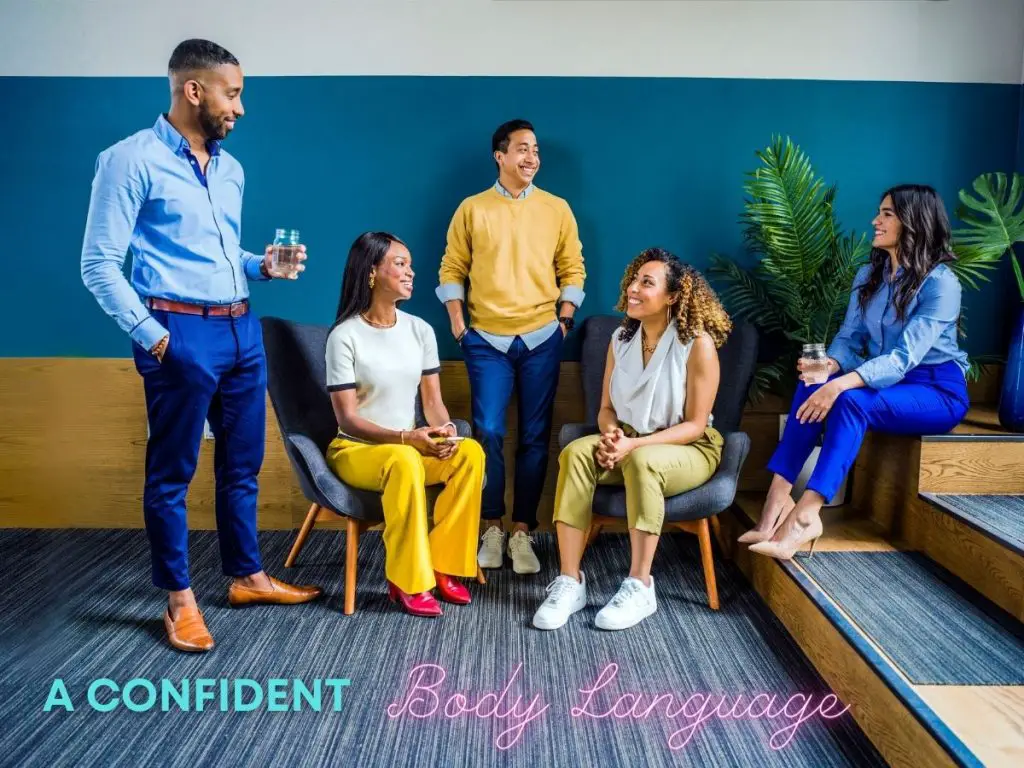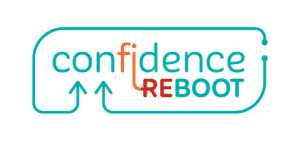Table of Contents
Confident Body Language So You Can Feel More Confident
Your actions produce your results. Your feelings produce your actions, and your thoughts produce your feelings. All of this, in turn, produces your results.
Your body language is controlled by how you are feeling and thinking. Consider you are constantly communicating to the outside world what is going on in your inside world.
According to Wikipedia, “Ray Birdwhistell concluded that nonverbal communication accounts for 60–70 percent of human communication.” source: https://en.wikipedia.org/wiki/Nonverbal_communication.
Behavioral and non-verbal communication speaks loudly and is communication nonetheless.
Whether you realize it or not, you tell everyone nearly everything 100% of the time. While other people’s awareness of body language can be high or low, wouldn’t you want to know what you are saying with your body?

Look at the image above. I bet you could tell me at least three things about each individual in the photograph and what they are thinking.
Body language is a powerful tool for sending signals to others. For example, to show you’re qualified during an interview, your body must stay confident. Maintain assuredness, so people will respect what you are saying.
The way you carry yourself is essential, especially regarding your confidence.
When you realize that you are influencing everyone around you by the way you carry yourself, you can take advantage of your own body language in ways that help give you what you want in life, as well as prevent sending the wrong kinds of signals to others.
More Confident Body Language – These Hacks Will Get You On Your Way
Be Intentional About Practicing Your Gestures (like an actor)
Record yourself or practice meeting yourself in the mirror.
I remember recording myself doing a sled push at the gym. In my head, I looked like an athlete straight out of a men’s apparel commercial working out to the most outstanding workout playlist of all time.
Later, when I watched myself on video, the scene would have been better set to elevator music. It was embarrassing. I looked more like Napolean Dynamite than Michael Jordan.
Why Is Confident Body Language Important?

Like it or not, we are constantly communicating with our bodies 100% of the time. We are sending messages that others will pick up on.
Much of what you experience is generated by how you interact with the world (and people) around you. You are constantly signaling social cues of how you feel about yourself and your environment.
You may be signaling subtle expressions of dominance or the opposite.
If you are sending the opposite, you may be passively inviting others into your life who want to dominate you.
If you want to improve your life, connect with what your body and facial expressions are communicating to everyone around you. Become aware of it so you can influence it.
Boost Your Self-Esteem – Controlling Your Body Language – Emotions “Loop”
Even if you don’t feel confident, practicing specific body language can increase your self-esteem and make it easier to be happy.
It may be helpful to remember that you live in an ever-present loop. Your body (actions and movements) can influence how you feel, and how you feel influences what you do with your body.
It’s like algebra. Whatever you do on one side, you ultimately have to do on the other side of the equation.
If you don’t feel good, change your environment. Change the music you are listening to, etc. One of my go-to actions is going for a walk.
Examples Of More Confident Body Language

In the next section, I go over some of the main things you can do so that your body exudes confidence in any social situation.
Confident Posture And Stance – #Alpha Stance
Don’t slouch. Don’t hunch. As you round your back and collapse your chest, you begin to impede your ability to breathe, speak, and move around.
A helpful way to think about it is when you hunch; you make yourself small. When you stand up straight, eyes forward, chest forward, and shoulders back, you make yourself bigger.
Big = Confident: Take up space with your body.
Mr. Miller, my chorus teacher in high school, told me to envision a string that was attached to the top of my head and was connected to the ceiling. Now imagine the line pulls you up slightly off the floor and then sets you back down on your feet. That is a confident posture.
Or you can imagine trying to touch the top of your head to the ceiling. This will get your spine and head into position.
Keep your Head Up – Chin Up Buttercup!
Have you ever seen the people that walk with a pot or bowl of fruit on their heads? This is an excellent way to envision how to position your head, neck, and chin. Try walking while you balance a book on your head.
A head held high is going to communicate confidence, self-esteem, and that you are present.
Make Eye Contact
Generally speaking, it’s good your head up and looks people in the eye (in acknowledgment). However, eye contact is a subject that deserves more attention. I’ve written many articles that you might like.
The takeaway here is that if you are in conversation with someone, you should spend between 40%-70% on solid eye contact. If it’s a love interest, this percentage may go up to 80%.
Think of it as a seesaw. Spending time in the upper range of 80% will have you tiptoeing into creepville, and below the bottom range, 40% is “walking dead” level disconnected.
Facial Expressions – Controlling The Not So Obvious
Facial expressions can be the most challenging aspect of body language to control. Most of us don’t talk to ourselves all that much in the mirror. So we aren’t really connected to what our facial expressions are doing when we are talking.
Take time to get a sense for how you look when you are talking to others. Practice appropriate facial expressions. Encourage feedback from people that care about you. Ask them how you come off, and what your facial expressions are like.
Beware of microexpressions. A subtle wince, smirk, grin can send the wrong message.
I remember meeting a potential client at her office. The sales rep that was shadowing me kind of had a very slight, subtle grin on his face while the manager we called on was explaining something serious.
She reacted aggressively and asked, “Why do you have that look on your face?” He said, “What look?” They went back and forth a few times. She ended our meeting and said, “Please never come back to my office.” He later told me that he had checked out of the conversation and was thinking of something funny.
Show Me Those Hands
The difference between being confident and uncomfortable is clear.
When it comes to your hands, open and visible is the way to go. If you spend time researching the handshake and its origin, it has to do with allowing others to know you aren’t armed and mean the other person no harm.
Confidence and open vulnerability seem to go hand in hand (pardon the pun).
People who are at ease with themselves move around easily, whereas those that don’t seem more prone to fidgeting. Nervousness tends to show up in one of two ways: Stiffness and fidgeting.
Pay attention to how you are moving. Are you stiff, rigid, and a bit lifeless in your reaction socially?
Don’t stuff your hands in your pockets or cross your arms and keep your hands tightly compressed against your body.
When it comes to how you communicate with your hands, keep them visible, relaxed, and open.
Be Approachable – Avoid Negative Hand Gestures Shielding Yourself From Others
It’s normal to feel intimidated when you are in a new environment or in the presence of people you don’t know. There is a reason that meet-and-greet events are often accompanied by alcohol.
There are actually two reasons. First, cocktails will lower your inhibitions and nervousness. Second, it’s a way for you to put something between you and someone you are meeting for the first time.
Remember when we used to play the game of chase as a kid? It’s always a good move to put some obstacle between yourself and your opponent. We can do this as an adult by placing a hot beverage between us and someone we are speaking to for the first time.
As you eliminate barriers between yourself and others, you are showing a sign of approachability and confidence.
Crossing Your Arms – Avoid This Defensive Position
Generally speaking, you will want to avoid crossing your arms. It signals you are in a defensive position and communicates that you are uncomfortable, holding something back, are feeling insecure, or experiencing self-doubt.
Kat crosses her arms when she is sleeping. I had never seen anything like it. I’ve speculated that it has something to do with sleeping on mats growing up. Maybe she did that so her arms weren’t on the floor. But at the end of the day, I assume it is simply genetic.
Your baseline may be arms crossed. Quite possibly, it’s the stance you take when you are contemplative.
Walk As If You Are On A Mission
Take significant steps/wide strides so that your heel strikes first. Head should be held high and eyes straight ahead. This conveys confidence and self-esteem. I like to think of it as the more you walk like you aren’t afraid of (and quite possibly could) falling down, the more confident you seem.
Take decisive steps as you advance forward.
Maintain Eye Contact As A Form Of Respect To Yourself And Others
Generally speaking, avoiding eye contact isn’t good. It can be a sign of many things ranging from social anxiety to anger. If you are in a conversation, the best rule of thumb is healthy eye contact is usually somewhere in between 50% and 70% of the conversation.
Below that, you will seem uninterested and above it, inching your way too creepy. Read all about healthy eye contact here.
Have A Firm Handshake
Handshaking is the first step in a new relationship and an essential part of building relationships. Here is the best way to start.
Hold your hand in a vertical position with fingers together (thumb facing towards the sky). Then shake their hands as evenly as possible.
Some people will try to turn your wrist in some twisted game of dominance. Don’t do that. All that communicates to someone who is “in the know” is make the other person leary of you from the onset of the relationship.
If you choose to use two hands, the first to shake hands and the second to reaffirm the gesture, don’t touch someone above the elbow.
Remember to shake with your heart as well as your hand. Unless you are in high-stakes negotiation, connect with genuine openness and optimism.
Mirror The Other Person’s Body Language
Mirroring means mimicking the body language of the person you are talking to. I’ve done this on many occasions.
I’ve never had anyone catch on. I think someone may have been mirroring my body language one time. When I noticed it, surprisingly, I wasn’t offended.
It didn’t come off as manipulative; instead, I took it as a compliment. I realized if they are going to go to all of that trouble to pay attention, then I think I’ll pay closer attention too.
Avoid The Body Rock
Have you ever seen someone speaking in front of the room, swaying back and forth? It’s a soothing practice. But it can have a negative effect on your listeners.
It can be helpful to pretend you are a tree and you have roots extending from your feet into the floor (or ground) where you are standing. Feel solid. Feel firm, and you will convey the message of confidence.
Stop The Fidgeting – Bobby Stay Still
I am so guilty of fidgeting. I do it when I’m driving and sitting at the computer. It’s pretty involuntary. I have to consciously tell myself to stay still like a mom yelling at her little boy to stop moving around.
Sometimes you have to parent yourself. The result of not learning to control this is making others around you feel anxious.
Read our article on How to Tell if Someone is Anxious.
Master Your Emotional State
As you can see, the list of things to think about can get extremely long. It can be hard to try to focus on more than two or three things at a time when it comes to presenting yourself in the best light with healthy body language.
The shortcut is to observe your feelings. When you watch your feelings, you get a chance to have a say in the way your life goes.
I remember learning in counseling years ago that I had to learn to separate facts and feelings. Just because I feel a certain way or believe something doesn’t make it true.
Here is the best way to observe your emotional state.
1. Understand that feelings come from thoughts, and feelings produce action.
2. Imagine there is a second you, and you are on the outside of yourself, watching yourself do life.
3. As the observer, notice the thoughts that (the observed) you are having and evaluate them.
4. Consider whether they are positive or negative and what is behind the thought.
5. If the thought is negative or makes you feel bad, thank your inner self for giving you the thought acknowledge it. Realize that part of you is trying to protect yourself.
6. Choose a new thought.
Position Your Feet Shoulder Width Wide
Stand still feet wide apart. About shoulder width is good. Don’t move around a lot. This will help you show centeredness and confidence.
Avoid shrinking, getting smaller or taking a smaller stance.
Learn To Listen
According to expert hostage negotiator, Chris Voss, it can be helpful to repeat the last 2-3 words that someone says to you back to them. It’s a sign of active listening and helps people feel heard.
Practice listening to others. Imagine that you will be tested later on what they told you. In doing so, they will feel honored and respected.
